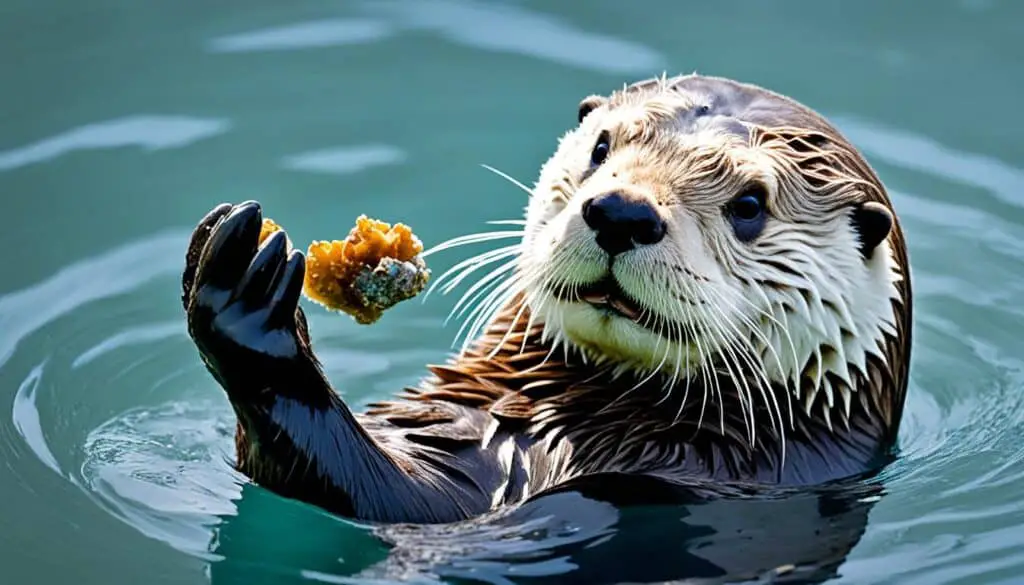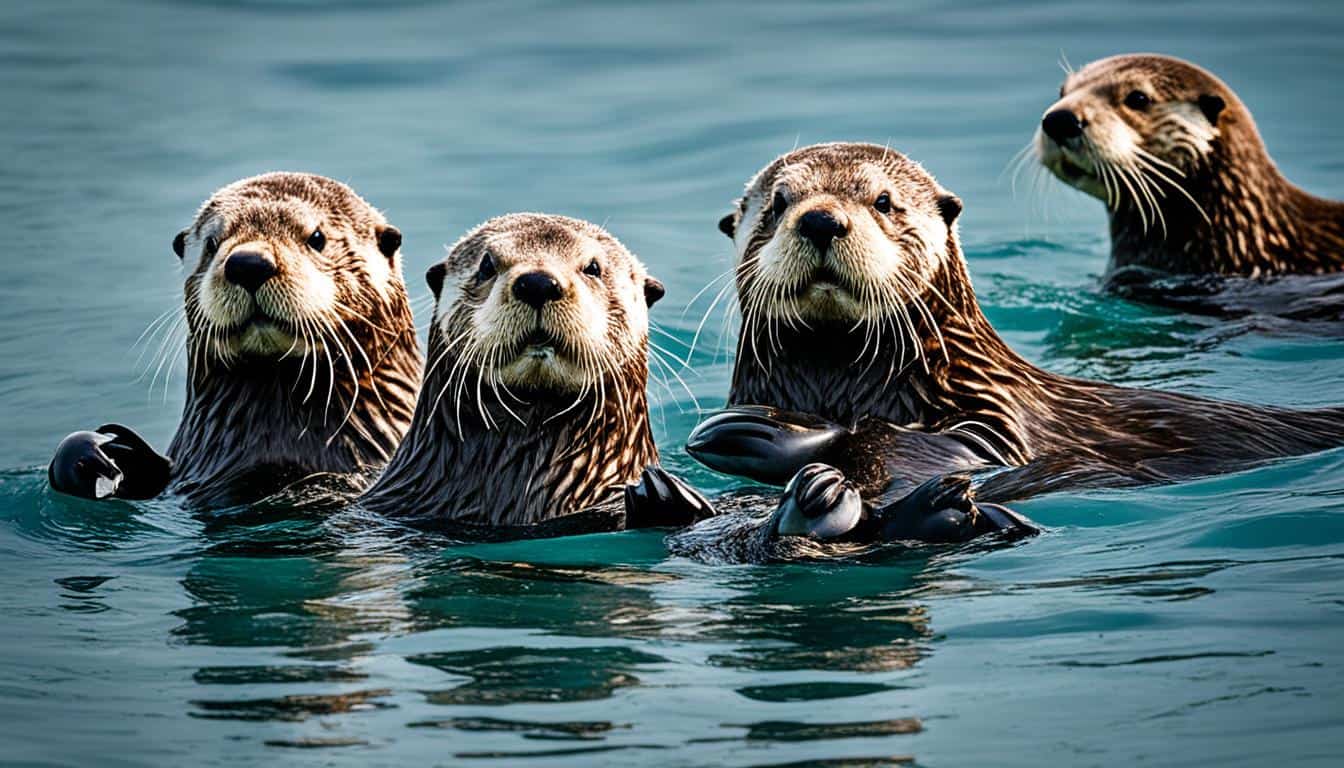Have you ever wondered how sea otters use tools? These amazing marine animals are known for their sea otter behavior. They use rocks and other objects to get food. This shows their sea otter intelligence and helps them survive in tough places.
Studies show that tool-using otters eat bigger prey and have less dental problems. This skill is key for females, who need to feed their hungry pups. The link between sea otter tool use, eating habits, and dental health is vital for their survival. It’s especially important as food becomes harder to find.
Understanding Sea Otter Tool Use
Sea otters (Enhydra lutris) are known for their amazing tool-using skills. They are among the few animals that use tools. This shows their adaptations to their habitat, helping them survive in tough places. Their tool use behavior shows how smart they are and how they find food in different ways.
The Unique Skill of Tool Use Among Sea Otters
Sea otters use rocks and shells to open their food, which is really cool. They are very skilled and adaptable. Each otter picks its favorite tools, which helps them in different situations. They learn from their mothers, which helps them get better at using tools.
Evolutionary Origins of Tool Use in Sea Otters
The reason sea otters use tools is not fully understood. But, it’s thought to be because they need to get to food that’s hard to reach. Over time, those otters that were better at using tools were more likely to survive. This skill helped them become great at finding food.
Variation in Tool Use Behavior Across Regions
Sea otters use tools differently in different places, depending on where they live and what they find there. For example, those in California use tools more often than others. The kind of food and the environment affect how they use tools. This shows how adaptable sea otters are in different parts of the ocean.
How do sea otters use tools?
Sea otters are experts at using tools, which is key to their eating habits. They use different objects to help them get food. This part will talk about the tools they use, how they use them, and how men and women otters differ in this.
Common Tools: Rocks and Beyond
Sea otters often use rocks to crack open hard foods like sea urchins and abalone. They pick rocks that fit their needs, showing they learn and adapt. They also use things like shells and even plastic bottles, proving they can adapt to different places.
Technique: Using Their Bellies as Workstations
Sea otters have a unique way of eating. They float on their backs, using their bellies as a work area. This lets them keep their tools and food steady, making it easier to open shells.
By doing this, they can eat more efficiently and get to food that’s hard to reach. This helps them survive better.
Comparison of Tool Use Between Male and Female Otters
Studies show that female sea otters use tools more than males. Females can eat prey that’s harder than what males can without tools. This might be because they’re smaller and need more food to feed their babies.

The Ecological and Dietary Implications of Tool Use
Sea otters use tools to get food, which helps them survive and affects their environment. They are very adaptable, especially when getting to hard-to-reach food with tools. This tool use is key to their diet and health.
Impact on Diet: Accessing Harder Prey
Tools let sea otters eat prey they couldn’t get to before. When their favorite foods like abalone are hard to find, they eat tougher things like crabs and snails. This flexibility helps them survive and has big effects on the ocean’s ecosystem.
Dental Health and Tool Use
Using tools helps sea otters keep their teeth healthy. Studies show that those who use tools the most have less tooth damage. Keeping their teeth strong is important for eating and living well. The link between tool use and dental health is crucial for sea otters’ survival.
Sea Otters and Their Role in Marine Ecosystems
Sea otters are key to keeping marine ecosystems in balance, especially in kelp forests. They control the numbers of many marine species as apex predators. Their role is crucial for biodiversity and stability in these environments.
Sea Otters as Apex Predators
Sea otters are vital to the health of marine ecosystems. They keep sea urchin numbers in check, stopping them from eating too much kelp. This is important for the life of these underwater forests, helping many marine creatures to survive.
The health of their environment shows how important sea otters are. Their actions greatly benefit their sea otter ecological role.
Impact on Kelp Forests and Other Marine Habitats
Kelp forests depend on sea otters. By managing sea urchin populations, sea otters help create a balanced marine ecosystem. This supports many aquatic species.
Their foraging does more than just control populations. It helps keep the entire habitat healthy. Healthy kelp forests are key to a diverse marine life, making the sea otter ecological contribution vital.
These forests also help with carbon sequestration, which is good for the environment.
| Ecological Impact | Details |
|---|---|
| Population Control | Regulates sea urchin populations to prevent overgrazing of kelp. |
| Biodiversity Support | Promotes habitat for fish, invertebrates, and other marine species. |
| Carbon Sequestration | Kelp forests absorb and store carbon, mitigating climate change effects. |
| Habitat Stability | Kelp forests provided by sea otters increase resilience against environmental changes. |
Conservation Efforts for Sea Otters
Sea otters are facing many threats like habitat loss, pollution, and getting caught in fishing gear. These efforts are vital for their survival as they are endangered. Conservation groups and government agencies are working together to protect them.
Restoring their natural habitats is a key goal. This means cleaning up the coast and making the water better. Laws also help protect sea otters and their homes.
When you help with sea otter conservation, you’re helping these animals and the ocean. Learning about sea otters and their homes helps us all. It shows how important it is to take care of our oceans.
FAQ
How do sea otters use tools?
Sea otters use rocks and shells to get to their food. This includes hard-shelled prey like sea urchins and abalone. They use their bellies to keep the tools and food steady while they forage.
Why is tool use important for sea otters?
Tool use helps sea otters get to a wider variety of food. This is key for their survival as their favorite foods become less common.
Are all sea otters tool users?
Not all sea otters use tools. But many do, and it depends on where they live and what they eat.
How does tool use affect the dental health of sea otters?
Sea otters that use tools have less dental damage than those eating softer food. Keeping their teeth healthy is important for their ability to eat.
What role do female sea otters play in teaching tool use?
Female sea otters often use tools and teach their young how to use them. This helps the young learn important survival skills.
What is the ecological role of sea otters in marine ecosystems?
Sea otters are top predators in marine ecosystems, especially in kelp forests. They control prey populations, like sea urchins, which keeps the ecosystem healthy.
What are the conservation efforts in place for sea otters?
Many conservation efforts protect sea otters from threats like losing their homes, pollution, and getting caught in fishing gear. These efforts include fixing their habitats and supporting laws to help them survive.
How do sea otters adapt their tool use based on prey availability?
Sea otters change their tool use based on what food is available. If their favorite foods are hard to find, they eat tougher species like crabs and snails.







